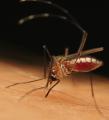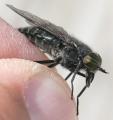Diptera.info :: Family forums :: Syrphidae
Who is here? 1 guest(s)
|
intersex and sex determination
|
|
| Louis Boumans |
Posted on 08-01-2007 00:31
|
|
Member Location: NO Oslo Posts: 268 Joined: 09.06.04 |
I found an intersex specimen of Platycheirus peltatus : it has largely female morphology, like eyes widely separated, but male genitalia (at least externally). The front tibia is of intermediate width, but the front leg lacks the bristles characteristic of the normal male. Searching for 'intersex' on this forum, I found this thread: http://www.dipter...9#post_439 I wonder, is this the kind of intersex discussed there? Does anyone know what causes this condition? (I suppose there can be multiple causes..) Unfortunately, my camera stopped working, so i can't spost pictures right now. And, now i'm thinking about it: what its the sex determination system in Syrphidae? I learned that in Drosophila it is the same as in us humans, i.e. an xx / xy system, but on the other hand, some lineages of Musca domestica have sex determining genes on autosomal chromosomes. So maybe this is quite complex and variable in Diptera?? |
|
|
|
| Adrian |
Posted on 08-01-2007 09:01
|
|
Member Location: Posts: 69 Joined: 05.01.07 |
Intersexes seem to crop up now and then in many dipteran families. In the Empididae, they are very common in a few species. On one occasion I netted several thousand in a 'swarm' of Hilara monedula (amongst which were a very few real males or females). I also recall that there is a Muscid (?) in the Faroe Islands which produces large numbers of intersexes in some years I think I read somewhere that large scale occurrence of intersexes is a limiting mechanism which decreases reproductive capacity at times when population outstrips resources. Not sure hoow this would work in practice even though it does seem to make good sense for such a mechanism to exist Hope this helps a bit |
|
|
|
| Zeegers |
Posted on 08-01-2007 16:18
|
|
Member Location: Soest, NL Posts: 19047 Joined: 21.07.04 |
Hi Louis Other than often supposed, the sex of an animal (both insects and all the way up to mammals) is not determined by their chromosomes, but by their hormons. And of course, the making of hormons is, in principal, regulated by chromosoms via for instance the hypothalamus in mammals. However, from time to time, this system fails (for mammals is the embryonal stage the relevant stage), producing 'intersex' or even 'opposite sex'. For instance, the actress Jamie Lee Curtis is supposed to be a chromosomal male. The big difference between insects and mammals is, that in mammals there is a constant rate of hormons, due to the blood circulation. However, this circulation in insects is much worse, so that the hormon level may differ from spot to spot. So, an insect can be female with male wing tip (very illustrative in the orangetipped butterfly), or any combination you like. Pollution, for instance by Cadmium, is known to result into a high rate of intersexes. Intersexes, when you look for them, are not really rare. In Tachinids, at least every one out of 1000 is an intersex in some sort. Theo Zeegers |
|
|
|
| Jump to Forum: |












